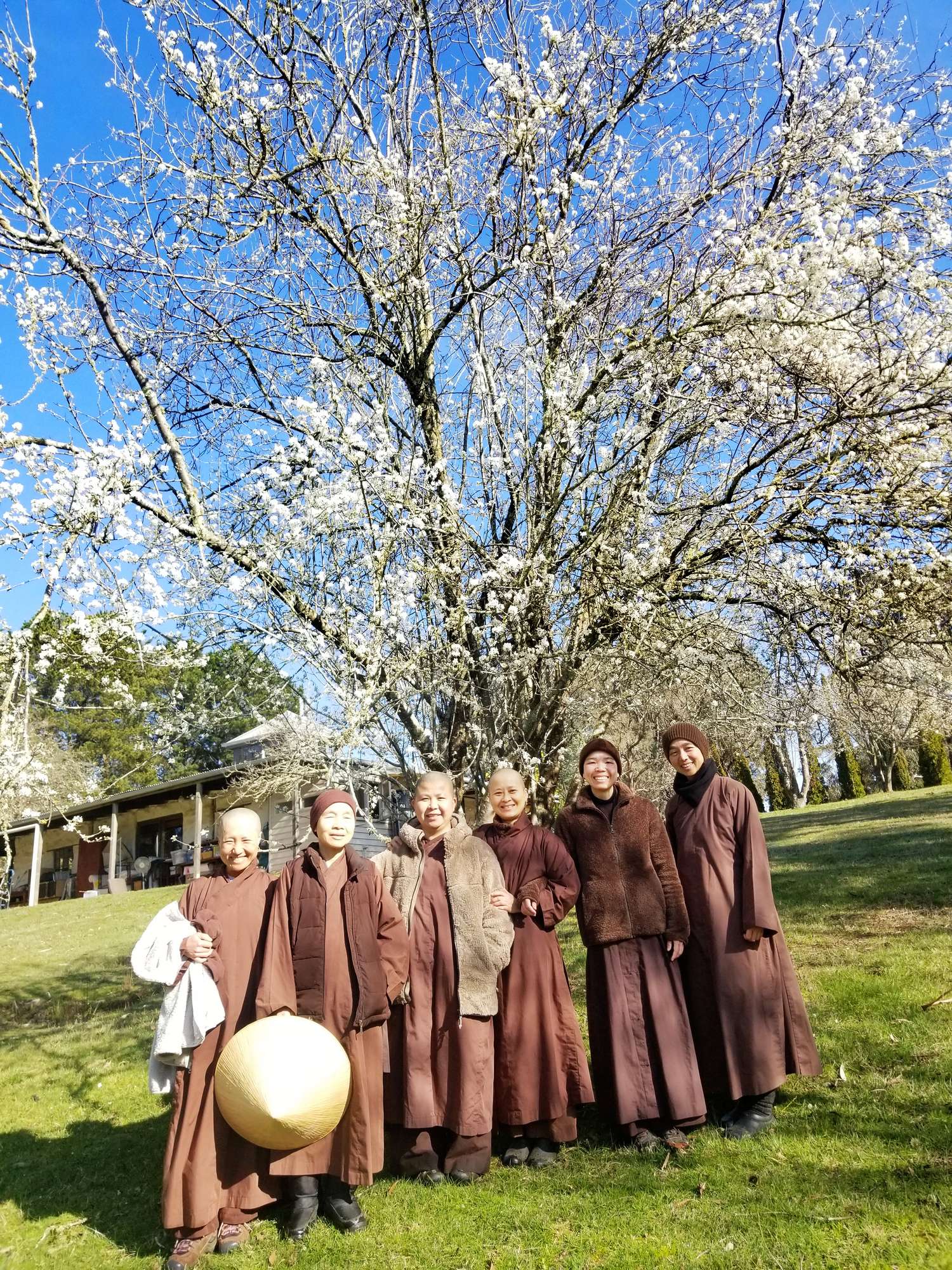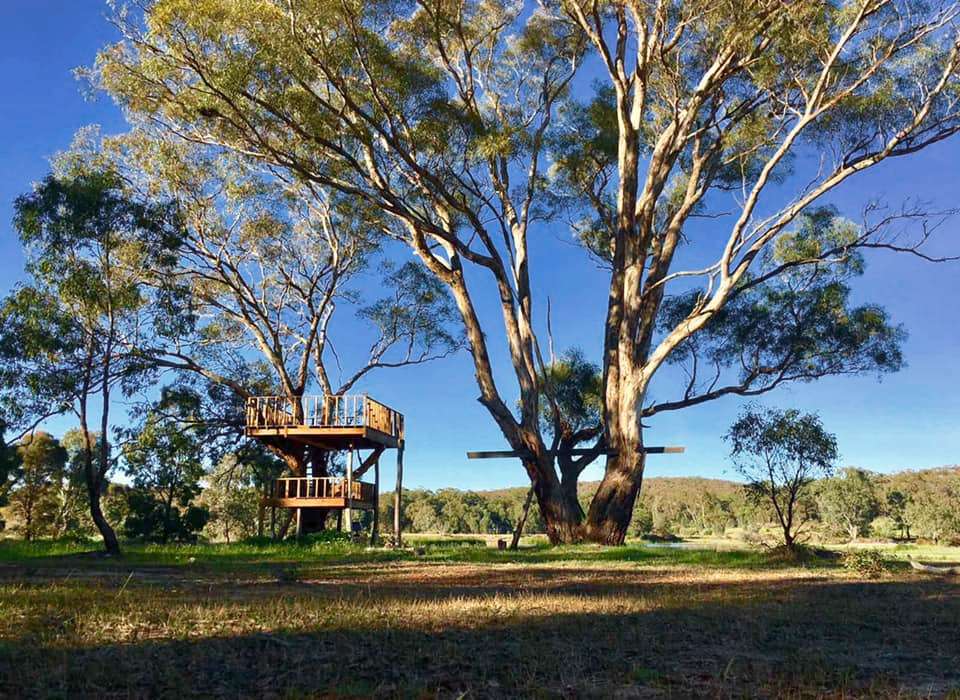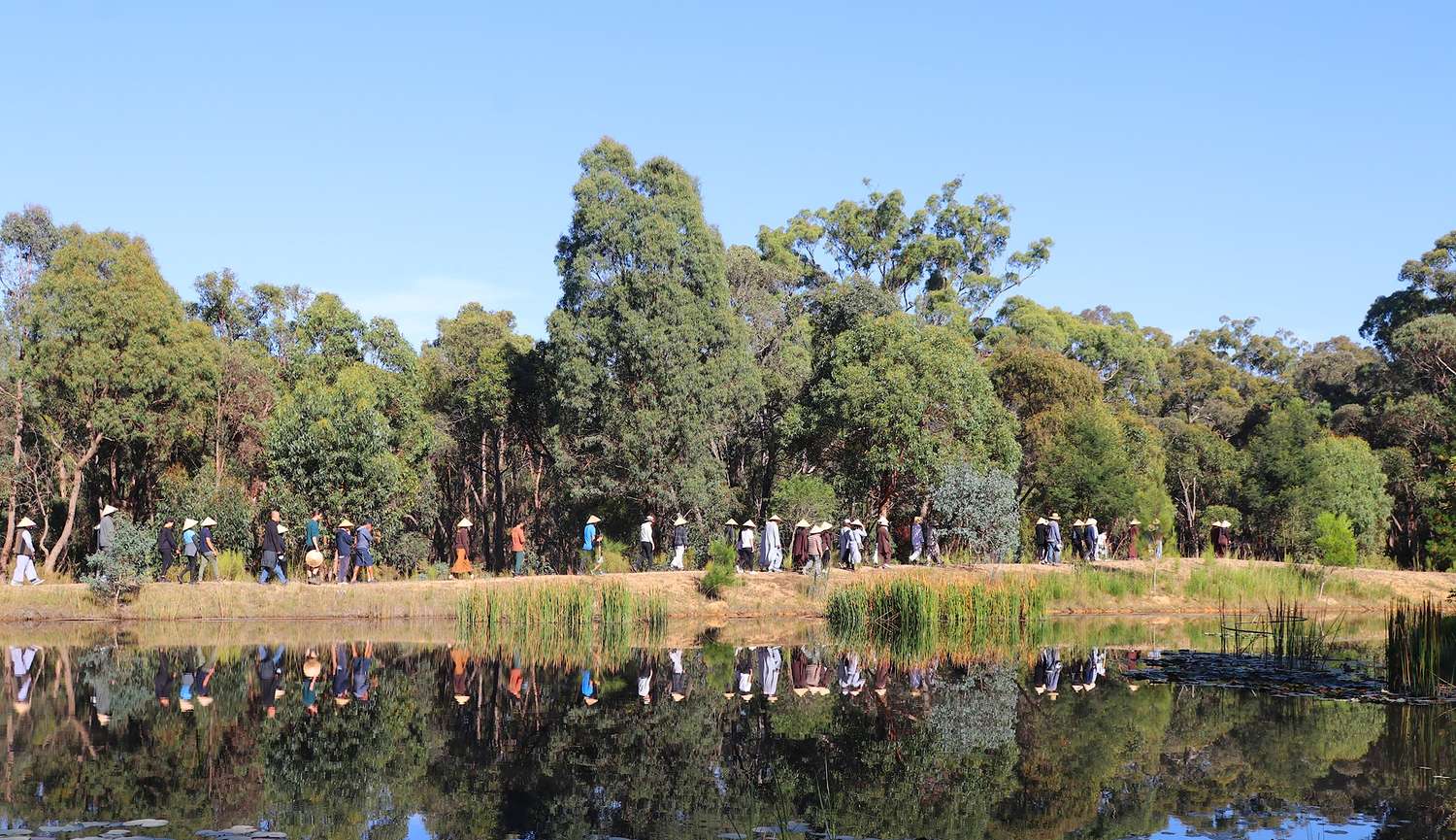Collecting Gum Nuts
Sister Chân Trăng Mai Thôn
A Journal from the Land Down Under
Arriving in Australia
Dearest respected Thay,
My sister and I were returning to Nhap Luu, our Plum Village Practice Centre in Melbourne, Australia, on a rather cold evening. Welcoming us along the way was a wombat running in front of our car, at a safe distance, lit up by the headlights. The sister who had picked us up had to slow down and wait for him to waddle to the side of the road. Everyone hoped that he would turn to look at us so we could see his face (most of us in the car had never seen a wombat before), yet he just kept running. That didn’t stop our excitement from spotting a wombat for the first time.
Getting out of the car, the cold air hit my face and woke me up. For the first two weeks in Australia, we were quarantined in a hotel in Perth. We only found out upon arrival that for the whole time, we were not allowed to put even one foot out of a 16-square-metre room. My lungs really welcomed the cold air–such good food for my respiratory system!
We made really good use of the two weeks by applying the practice of dwelling in the present moment, recognizing conditions of happiness, connecting with the local sangha, and using the opportunity to understand each other more.
Familiarity and unfamiliarity
Stream Entering Monastery (“Nhap Luu” in Vietnamese) was relocated to Porcupine Ridge, a green and quiet town, in June 2021, just before the 3-month Rains’ Retreat. When we arrived, there were only five sisters, including Sister Trung Chinh, who had joined for the 3-month retreat. After that she would return to Deer Park Monastery in California for the Great Ordination Ceremony. And so, including us two newcomers, the monastery only has six sisters in residence.

The first few days after arrival, I had a sense of both familiarity and unfamiliarity. There were quite a few things that were different from New Hamlet (Plum Village, France), where I had stayed and practised for many years: the washing machine, the kitchen, the dining hall, the recycling bin, and the sangha size, which are all so small compared to the size of things in Plum Village, France. In short, there were so many things that I had to get used to. Here in Australia, one more unfamiliar thing is that when you go to town everyone speaks … English. The first few weeks, when friendly Australians said “Hello” to me, I habitually responded “Bonjour!” Then suddenly I realized where I was and a little embarrassment kicked in.
On the familiar side, the size of the land here at the monastery is a bit like New Hamlet, although it is more hilly. The land is not too big–just enough space for me to enjoy and for a “little aging person” to climb up those little hills without their legs getting too tired. The schedule, practices, and activities here are maintained regularly, which helped me to fit in right away without any effort.
Fortunately, after arriving, we were still able to join the last few weeks of the Rains’ Retreat. The schedule was consistently maintained despite the bitterly cold winter weather. Every morning, lay people joined our sitting meditation and chanting via Zoom, except on Mondays. After Sr. Sinh Nghiem came here, she also led Qigong exercises on Zoom after the morning session. In the beginning she only intended to do it for her parents and herself, but many people joined in so it eventually became quite popular. Now she has been able to organize a group of monastics and lay friends to lead the Qigong exercises every morning.
The gift
Nature here is very generous. Kangaroos visit our green lawn around the nuns’ residence every morning and evening (though there have been fewer visits when we have more people here and in summer). Spring is when all species try everything possible to ensure their continuation. There are several small ponds in the precinct of the monastery–an ideal environment for the wild ducks to raise their youngsters. Observing the ducks parenting their young, we gradually recognised them individually. I could recognise some childless couples, childless groups, a lonely and childless single duck, and a single mother duck with five ducklings.
I paid particular attention to a couple with four ducklings because they claimed the whole grassy area around the nuns’ residence. They allowed the sisters to come quite close, but not the other ducks which they would chase off right away. The way they took care of their young was very interesting. The parents simply followed their ducklings wherever they went. They would be there to observe and protect. When other ducks approached them (surprisingly the childless ones tried to do it all the time and I suspected that they wanted to abduct other people’s, no, other ducks’ children), and if it was still safe enough, the parent ducks would go between the strangers and the kids without doing anything else. They would then gently walk in the opposite direction, and the ducklings would just naturally follow them. Only when the naive ducklings were too busy eating and unknowingly moved toward “the enemy” would the parents then chase the strangers away.
Sometimes while observing the lively wildlife around here, we merged with it without knowing. It was so nourishing and healing for us. One time, a sister was filming an echidna who was looking for food when suddenly, the echidna looked up at her and walked towards her, eventually putting its snout in the gap between her toes. She had to jump away! What kind of food could one find there, I wondered?
One heart
Although there are only a few sisters here, the schedule and practices are no different from New Hamlet. We have been able to maintain a few basic practices that I have loved since my novice time. For example at lunch time, after the Five Contemplations have been read, if we are late, we do not come into the dining hall but wait until the two sounds of the bell at the end of the meal are invited. That way we all try to come on time.
A few weeks after our arrival, we had an online retreat. Covid-19 was still very active Australia-wide. We couldn’t offer our retreats in-person, one for Vietnamese speakers and another for English speakers, as originally planned. So we did an online retreat in two languages.
It was the very first time a Plum Village online retreat was held in Australia, the first time Nhap Luu led one, and the first time we hosted one at the new premises. We were not sure of our capacity–for example, how strong the Wifi was – so we decided to limit the number of attendees to between 100 and 110. In the beginning, we thought it would not be so popular, so we asked the Plum Village websites (Vietnamese and English) to publicise it. But so many people from Japan, China, South Africa, etc. registered that many Australians ended up missing out. They expressed their sadness and we felt a little bad. Even so, we didn’t want to receive more people because we were unsure about the Wifi capacity.
The six sisters here tried to cover everything: organizing, registration, giving Dharma talks, facilitating Dharma sharings, offering total relaxation, giving workshops, and running the daily rotation in the monastery, including cooking. Yet, the retreat happened very smoothly and successfully. We are thankful to our lay friends for their technical support and translations. Many fruits of the practice have been shared by our retreatants and published on nhapluu.org to inspire others. We feel very lucky to be able to join this flowing stream.
Nourishing
Spring in the land of kangaroos starts in October. Looking at each flower, each leaf from their budding till they fully flourish, I can see how wondrous the vitality of nature is. I don’t know why I enjoy young leaves so much. I enjoy them even more than I enjoy flowers. In Australia, most of the land is desert. Rainfall is scarce. Seeing the young leaves shooting out in early spring, I have a lot of gratitude in my heart. The green colour of the leaves here is different from the green of the leaves in Europe. They are not lush, but a little “austere.” They are beautiful in their austerity because they carry within themselves perseverance, resilience, and patience. They have to be self-sufficient in a way. Over countless generations, they have learned to become narrower, thick, and tough to preserve water. They work hard to help the root system to nourish the tree. Without them, the tree wouldn’t be able to survive.
Last year New Hamlet launched a tree-planting program to replace some dead plum trees with young almond trees. Each sister sponsored one, two, or more almond trees (to water and care for them) for the first year of planting. The New Hamlet Care Taking Council prepared name tags with beautiful ribbons for us to tie on the trees that we sponsored. After planting the trees and tying our name tags on, we certainly felt close to the trees, as if the trees had somehow become our own children. Sometimes I saw brown robes in the plum orchard and I knew that the sisters were visiting their trees. Some sisters even brought along a water bottle or two during walking meditation for their trees, really pampering them. I was no exception.
I visited my tree, talked to it, and put a few branches around it to stop the neighbour’s goats and sheep from nibbling on it. I was thrilled when spring came. The weather was warm enough for some young green leaves to come out. One day, upon visiting my tree, I saw its young leaves had been eaten by insects–only some skinny leaf skeletons were left. As soon as I saw it, I knew that the tree would not be able to make it. I was sad, but I couldn’t do much as the tree was still very young and the leaves were not able to regrow.

I thought about my bodhicitta. At the beginning of time, it started as a cell. After countless generations, it became a seed, germinated, and sprouted. Maybe right now, my bodhicitta (and that of some of my siblings) is still at this stage, still a young bud. Probably it needs to go through many other stages or lifetimes to become as strong, solid, and powerful as Master Empty Cloud’s, Thay’s, or other great figures in the meditation circle. However, the presence of those young buds is still very wondrous. Without the young buds, there will never be leaves, never be flowers. Young buds are extremely important because if the young buds are eaten up, as my almond tree’s leaves were, then there’ll be no hope for the survival of the tree, not to mention the possibility of the tree to root deeply.
Daily practices and protocols that seem to be insignificant, in fact, are effective insect repellents to prevent the young leaves from being eaten, leading to the death of the tree. Isn’t that right, dear Thay? Wisdom that has been accumulated over thousands of years by countless generations of high monks and nuns is inconceivable and inexpressible.
Here in my new environment, consistent and diligent daily practices are our protection. Without them, with just a few monastics, we wouldn’t be able to walk the long path.
Letting go
Prior to joining the sangha here, we reminded each other to open ourselves to new experiences. Don’t keep saying “In New Hamlet, it was like this, or like that.” Yet sometimes we still catch ourselves saying that exact phrase.
In Australia, there are smooth barked gum trees. In the summer, they shed their bark. This bark shedding is called “decorticating” and is a normal thing to see. The trees need to shed their bark in long strips in order to grow. These strips get caught between the branches, dry up, and wait for strong winds to fall down. We collect them for our winter wood heater. During walking meditation, I see that the trees, after shedding their bark, reveal a new smooth young skin. I feel like I’m receiving a Dharma talk about letting go. The bigger the tree, the longer the strips of bark. This decorticating process is non-stop. The tree can only grow when the outer skin breaks into strips and falls down.
What I have known, learned, experienced, and done can easily become a citadel in which I hide. I then face the possibility of losing an opportunity to decorticate in order to grow.
Daily life
He is sixteen. Last Christmas and New Year holiday he was sent to Nhap Luu to stay with the sisters. His parents and younger brother visit him once a week. In Australia, the school holiday at the end of the year lasts six weeks. His family planned to send him here for six weeks, but the sisters cautiously told him to try for two weeks to begin with.
Apparently, he is a gaming addict. After the school holiday he will go into the final year of high school. He is very smart yet without direction in his life. Prior to coming to the monastery, he prepared himself to just join the sisters at meal times and mindful service. Other than these, he would not be there for sitting meditation, walking meditation, or have any contact with the sisters. In the beginning, he responded reluctantly when asked. Not even one week later, he was already chatting, smiling, and laughing with the sisters. He started joining in with the walking and sitting meditation. In a Dharma sharing session, he said that the sisters are “normal,” not as he had thought. He still has a long way to go, but his face is brighter and lighter, his steps are dragging less. That is indeed a success.

Dear Thay, these stories of transformation of the lay people who join us in the practice are similar across Plum Village centres everywhere. Stream Entering Monastery is no exception.
When people first come here, they look sad and depressed, and are often on the verge of tears. We don’t do anything special outside the normal schedule: sitting and walking meditation, guided meditation, etc. These things we do year in and year out. Yet just after a few days of practice, they already look different. When they come back, they bring with them their friends and partners. We know that just living our daily life in the monastery is enough to generate the good, the true, and the beautiful.
It is said that when people get old, they live on their memories. Whether they are good memories or not, they still live on them. I wonder if it is different for an “old monastic.” I reckon it isn’t. A younger monastic sister of mine asked, “What is it like for you here in Nhap Luu? Is it too cold for you?” I told her, “As I know this is the place where I am going to live, I will befriend the cold, the hot, and whatever is here.” I am living here, in the present moment. I am producing a beautiful presence, so that when I get old, really old, I will not go against the norm, which is to live on my memories, but they will be beautiful memories.
From the day I was ordained to become Thay’s monastic disciple, I have been living wholeheartedly as such. Looking back on my days, months, and years as a monastic, I would like to follow Venerable Ahimsa in saying, “Since the day I was born in the noble Dharma, I regularly dwell happily in the present moment. By that merit, by the time I live on my memories, may I be able to recount my past days, months, and years as well as my days, months, and years to come with a lot of joy, beauty, and wholesomeness.”